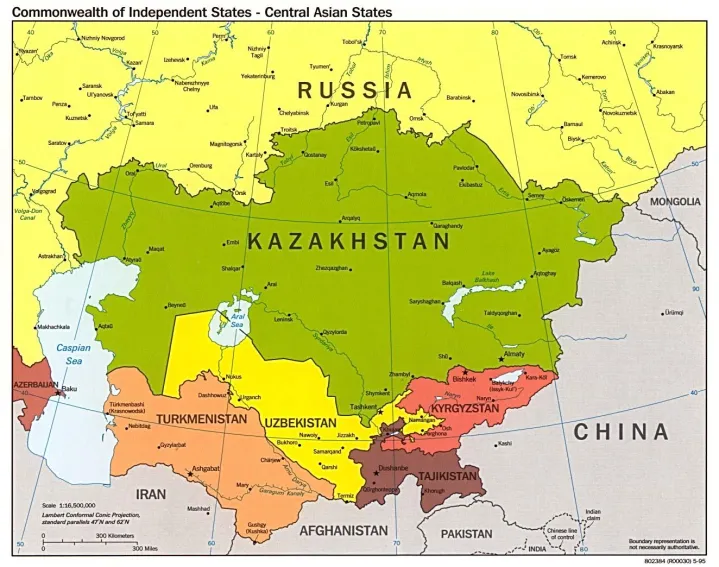
What Asian bankers must know about the New Great Game in Asia
By Azam AliIn the wake of ongoing impact of global financial and economic meltdown, particularly more acutely on advanced economies, sparing for the time being it’s full brunt on Asian economies; It is a compulsion for Asian bankers to be aware of threats and opportunities that are enveloped in The New Great Game, which is being played by the big powers in the heart of Asia.
The New Great Game, which has entered the end game phase, perhaps sooner than the involved big players deemed it to last, will not give time to big players to fully play their game of thrones, owing to; gradually declining oil production potential of existing oil producing countries, drastically rising demand for oil in advanced and developing countries alike, the global financial and economic meltdown that has particularly effected the economies of EU and US and its trickledown effect on rest of the world, new political and populace awakening in Central Asian States and other developing countries, which is empowering their independent postures in line with their respective national interests.
The end game is rapidly unfolding and it is time for Asian bankers to embark on repositioning their international banking focus. Without intricate understanding of the parameters of geostrategic, geopolitical and geo-economics of the big players involved in the New Great Game, it would be quite challenging for the managements of international and Asian banks to strategize their intervention policies and investments; with respect to budding financial investment destinations in Asia; which are getting ripe for capturing gains that are about to spout.
In the times of Anglo- Russian rivalry, Arthur Conolly, an intelligence officer of the British East India Company, being involved in espionage activities at the time, was captured in Central Asia. An Uzbek Amir threw him into a well filled with vermin and reptiles; after two months what remained of him was brought out and beheaded. The phrase “The Great Game” was found in his papers as quoted by a historian of the First Afghan War.
Later, a British novelist Rudyard Kipling used this phrase in his novel “Kim” and immortalized it. Since then, the phrase “The Great Game” refers to strategic conflict between British and Russian for supremacy of Central Asia. The British suspected Tsar’s endeavors for domination of Central Asia as a preemptive move for capturing Afghanistan and ultimately launch invasion of British Raj; it’s prized possession, and win adjoining gain of excess to warm waters. This was the old Great Game.
See Figure 1.
In recent times, the phrase “The New Great Game” implies geopolitical, geostrategic naval and military positioning on sea lanes and on strategic lands, extension of overt military presence, interventions and covert actions, carrot and stick diplomatic policy maneuverings and geo-economics dependent targeted investments by multinationals and public owned corporations, whose parentage rests with one or the other big power players involved in The New Great Game.
The sole intent of each big player is to bring Central Asian Region under its sphere of influence, so as to monopolize; create access to its untapped oil and gas reserves and as recently confirmed by US geologists, its newly discovered mineral wealth, and manipulate ascertaining of one or the other energy and trade corridor that conforms to their sphere of influence and multivariate interests.
The Central Asian Region share border with Russia, China, Afghanistan and Iran, together with Pakistan and Middle East in close proximity; this geographical positioning presents a huge potential for prompting new global trade avenues, energy supply and trading hubs and essentially repositioning focus of international banking and finance centers in Asia.
In the backdrop of above facts, coupled with; disintegration of Soviet Union, rapidly emerging economic and martial ascendancy of China and to an extent India and other emerging economies in Asia, growing influence of Iran in Eurasia, dwindling oil and gas reserves in oil producing countries; which are fast approaching the end of their finite life span that some experts predict will be exhausted by 2040, recent global financial and economic meltdown that triggered downslide of West’s global economic and political dominance and spurting political awakening of populace in the developing world has added complex geostrategic, geopolitical, geo-economics and finance matrix to the New Great Game.
The parameter of the theater of “The New Great Game” has now expanded to include the African continent. The oil tankers that bring supply of oil from Gulf States and eventually will be bringing Central Asian oil to Europe and North America sails across Africa’s coastline and into Mediterranean, for onward destinations in the West.
As such, this continent’s sea lanes are the lifeline of the West; their energy supply and trade maritime corridor that power their economies and support their lifestyle.
Another facet of these strategically important Africa’s sea lanes is the outreach it will provide to big players of “The New Great Game” to this continent’s oil and available raw materials, alongside the budding potential as final destination for marketing goods to this continent’s rapidly emerging economies.
At present, the sea lanes are under the waning dominance and protection of US and NATO, except the part that passes through Persian Gulf, which incidentally is out of the equation of Western dominance and its comfort zone, owing to Iran’s independent geostrategic and geopolitical stance, much to the distress of US and EU.
A new dimension to the African energy maritime corridor after the onset of West’s economic downslide is the dwindling capacity of US and EU to finance safety of this maritime corridor; this fact can be gauged from the increasing episodes of piracy in the Indian Ocean. The China, Russia and to an extent Iran’s growing naval presence in the same waters, coupled with China’s on ground presence through strategic investments in Africa and Mediterranean coastlines, are pointers of emerging power players that are swiftly closing in on epilogue of the unipolar world chapter.
The Central Asian Republics are in offing vital major world supplier of energy and minerals. The well endowed Kazakhstan with estimated 30 billion barrels of oil reserves making it 6th in rank globally in terms of natural oil reserves; out of 110 elements of periodic table, 99 are discovered in Kazakhstan. Azerbaijan has estimated 7 billion barrels of oil reserves. Turkmenistan has the world’s 4th largest gas reserves, while Kazakhstan and Uzbekistan follow close.
Thus collectively, the Central Asian region contains about 46 percent of global oil and gas reserves. Tajikistan and Kyrgyzstan that are deficient in hydrocarbons resources, have water, which is the biggest potential source of power generation in Central Asia, additionally Kazakhstan is rich in iron and steel. The Kyrgyz Republic has the 8th largest goldmine in the world. Beside the region’s oil and gas and minerals wealth, it has a huge agricultural potential, with Kazakhstan, Tajikistan and Uzbekistan producing large quantities of cotton.
Interestingly, vast deposits of minerals have been confirmed in Afghanistan by American geologists; prominent among the minerals are enormous deposits of lithium, which alone has the capacity to boast the Afghanistan’s economy. However, the most economical way of moving the ore from this landlocked state to the nearest seaports for onward shipment to destinations across the globe is the constraining factor for the moment.
Another interesting reality is Pakistan, which shares its border with Afghanistan. Apart from Pakistan’s geostrategic position in the context of excess route for landlocked Afghanistan and Central Asian Region; is a country that is quite affluent in natural resources. It has enormous untapped energy surplus resource both renewable and nonrenewable, have world’s second largest salt mines, second largest coal reserves, fifth largest copper and gold reserves, seventh largest in production of wheat and rice and has huge recurrent exportable surplus in cotton, enormous potential in livestock, dairy and fishery, manufacturing, mining and quarrying. It is the sixth most populous country with over 63 percent population under the age of 25 years, giving it an edge in human resource. Apart from the above, once the energy and trade corridor commence operation through its territory, it having a well developed services sector, including a vibrant banking sector that has the capability to assume the role of strategic financial hub in this part of the world.
The New Great Game in recent times has six players, each having specific interests in the region. The six players involved are United States, Russia, China, Iran, Turkey, India, and Pakistan. This New Great Game unfolding in the heart of Asia has brought Pakistan in the forefront, owing to its geostrategic location, which can unlock shortest intercontinental trade link and energy supply corridor. The Gawadar deep seaport in Pakistan is the nearest trade and energy resource transfer hub from Eurasia to the rest of the world. As such, Pakistan has much to offer and gain from “The New Great Game” and can provide fillip to globe trade, unleash rapid economic development potential in Asia and help in quenching global thrust for oil and gas.
Considering such opportunities and untapped natural resources in Central Asian Region; global economic powers are attempting to undo each other in penetrating the Central Asian Region, through investments in infrastructure that would achieve twin objective of exploitation of its natural assets and bringing this region’s energy supply corridors under their sphere of influence.
Since Kazakhstan, Turkmenistan and Azerbaijan the three oil rich republics are landlocked, hence for big players of “The New Great Game” in addition to eyeing exploration and production of oil and gas opportunities, have compelling imperative to ascertain the routes through which it can be piped to the nearest seaports. The countries through which pipelines will pass are equally important. With this scenario, the current race for establishing pipeline routes is a complex game being played by the big players; each asserting its preferred route, one that conforms to its geopolitical, geostrategic and geo-economics interests.
The Russian growing monopoly in the energy sector, giving it political and economic exploitative edge over US and EU is a highly geostrategic and geo-economics discomforting element for them. This emerging scenario can only be arrested by the aperture of alternate routes. However, Russia at present by not tying any political conditions in its relations with the Central Asian States and growing deterioration US relations with the same have for the time being turned the region’s dynamics in its favor. Besides, the Russians have an edge over other players by having previous multiple affinities with the Central Asian States. The China however appears to pose a substantial threat to Russia in the sphere of trade, banking and finance, security engagement, regional cooperation and possessing a technically and economically highly feasible energy supply and trade corridor through its territory, with assurance of direct excess to warm waters through Pakistan with which it traditionally holds extremely cordial relations in all affairs.
The US ambition of controlling the Caspian Sea that contains world’s largest untapped oil and gas resources, alongside Central Asian Region’s geostrategic location at the cross road of Asia, Europe, Persian Gulf, Middle East, South and East Asia and Far East, surrounded by fastest growing economies of China, Russia and India, has pitted it against China, Russia and Iran, which are the three emerging regional power players in the vortex of “The New Great Game”.
On the ground the US and European Union interests and involvement in Central Asian states has varied since 2001 owing to; their own political inconsistencies, instability in the region, and Central Asian States dexterous policy of maintaining their independence and refusal to come under sphere of influence of any one big player. As a result, presently US have lost on diplomatic front against Russia and China.
Holistically, the US agenda is to contain influence of other big players in the region, so as to attain influence for indirectly controlling Central Asia States natural resources. Fulfilling its policy imperatives, US energy firms have invested heavily in oil and natural gas development and are desperately exploring routes to the Western side of the Central Asian Region, for hauling these resources in the most economical and secure way.
China’s interest in Central Asian states is to consolidate interlinks using trade and transport links, thus prompting a new Silk Road. At the strategic level, the purpose is to develop shorter alternate route that could avoid other treacherous sea routes, and can effectively create a land bridge between China, Europe and rest of the world.
The Chinese are rapidly developing its own railway infrastructure and investing heavily in Central Asian region’s railroad systems, which eventually will interlink Central Asia; ultimately paving way for energy and trade corridor.
To establish this land link, China is concentrating on eventual opening of east-west trade route; with this purpose China is developing infrastructure plans across Afghanistan to join it with Gwader, the deep seaport of Pakistan, which it helped develop and is now fully operational under active collaboration of China.
Simultaneously, China is focusing on fully functional direct land link between China and Pakistan through Karakoram highway, with the objective of establishing an alternate land link with Arabian Sea.
It would be interesting to see what prospective energy and trade corridors are available to the landlocked Central Asian Region and how the big players of The New Great Game are endeavoring to secure the corridor that best serve their interests.
The Northern Route matches with Russia’s strategic interests. The Russian are aggressively pursuing strategy for positioning itself prominently in the energy sector and securing its borders with southern Central Asian States through positive diplomatic engagements and infrastructure investments.
The Northern route can provide landlocked Central Asian States excess to global markets for oil and gas through Russian territory; additionally it will help Russia attain strong geopolitical and geo-economics position over Europe and US.
This route compels extension of existent pipeline network of Kazakhstan to Russian network; this requires building a pipeline from Baku to Novorossysk.
The Western Route can link Azerbaijan’s pipeline to Georgian black Seaport of Supsa for onward shipment via Bosporus to Europe. Turkey contends that Strait because of its incapacity to cope with the super tanker traffic, thereby it propose an alternate linkage from Baku to Turkish port of Ceyhan on Mediterranean. The high cost of laying pipeline on Western route is the constraining factor and thus makes it an unattractive option. However, Azerbaijan, Georgia and United States are in favor of this route.
The Southern Route implies pipeline link between Kazakhstan and Iran, thereby making Persian gulf the hub for global energy supply. Although this route is economically most feasible, but it undermines Gulf countries security, eventually making it unattractive proposition from the standpoint of US and Gulf countries.
The Eastern route can transport oil through pipeline from Khazakhstan to China, thereby establishing supply link to Pacific Ocean.
This route has the potential to meet phenomenally growing energy requirements of Asia. The constraining factor of this route is the cost of building 3,700 km long pipeline.
The Southeastern Route entails transportation of oil through pipeline from Turkmenistan through Afghanistan on to Gawadar deep seaport of Pakistan. Simultaneously, a gas pipeline initiating from Turkmenistan passing through Afghanistan onto Pakistan, from there it will pass on to India.
This route will create huge benefits for Afghanistan and Pakistan in terms of transit fee and to India is ensured a steady energy supply. The flip side of this prospective route is volatile situation in the concerned states at present.
Summing up, the New Great Game is a series of strategies for tying together Central Asian States and creating an energy and trade corridors that could link the landlocked region with the globe. Each of the three big players; China, US and Russia are focusing on priorities dictated by their varying geostrategic, geopolitical and geo-economics interests.
There are international players, big petrochemicals and other international corporations with high stakes in “The New Great Game”. One thing is certain; no one player can completely monopolize energy and trade corridors.
The global financial and economic meltdown that has engulfed US and EU economies in particular, couple with China and India growing thrust for oil and gas and trade channels openings for their goods and services, Russian interest of gaining lost status as competing economic and military power so as to counter balance US and NATO dominance, will force compromise in the pipeline and trade corridor tussle sooner than later.
The big players of “The New Great Game” are aware of the fact that failing in opening multi energy and trade corridors will plunge the world in uncertain economic future reflecting in growing poverty and ultimate civil strife in advanced and developing countries alike, and may lead to wars in every region of the world for gaining access to oil, gas, minerals and water. This time around one thing is certain thou; no single power player can emerge as ultimate winner in
“The New Great Game”.
The Asian countries that will presently undertake repositioning of their trade, commerce, banking and financial sector linkages will take full advantage of all encompassing gigantic opportunities that are about to spring open in the wake of envisioned swift end of “The New Great Game”.
Under the current global economic scenario, the first energy and trade corridor that will be operational in the near future is expected to be the Southeastern Route; making Pakistan the most important country in terms of; excess point to global sea lanes, provider of services in the sphere of banking, trade and commerce, logistics and security.
Consequently, Pakistan will become one of the favorite Foreign Direct Investment destinations in the region. As far as Central Asian states are concerned, they are already in the limelight as far as foreign direct investment is concerned. However, it lacking in well developed banking and finance sector, presents immense opportunities for Asian banks and finance houses.




















 Advertise
Advertise







